Fallen
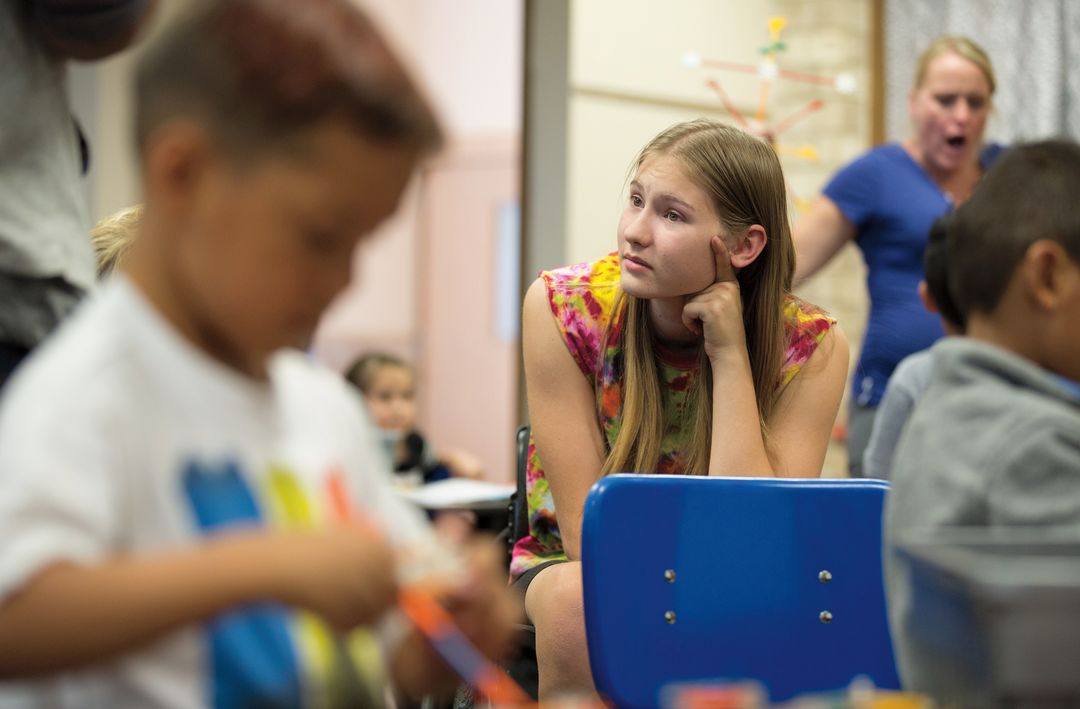
Kailyn Forsberg mentors students as an after-school aide at Gypsum Elementary, where her father serves as principal.
Image: Dominique Taylor
At dawn on April 7, the time of day when most Copper Mountain regulars hit the snooze button instead of venturing out into the brittle cold, Kailyn Forsberg stood at the top of Copper’s slopestyle course, blazing with excitement. The 15-year-old Eagle freeskier had won silver medals in the preceding days’ halfpipe and rail events at the USA Snowboard and Freeski Association’s national competition; today’s contest was slopestyle, her favorite of the three, and she was gunning for gold.
Few doubted that Forsberg, a physical prodigy in a valley overpopulated with gifted young athletes, would be able to claim it. She had learned to walk at a precocious nine months, and she started skiing four months after that. Wielding a golf club by age two, she sent balls soaring 75 yards. She played football alongside the boys through seventh grade, stoically enduring their extra-hard hits and eventually earning the respect of her teammates and their fathers. Then she switched to girls’ lacrosse, for which she played defense “like a ninja,” says her Eagle Valley High School coach Stephanie Renzelman. Interceptions were her specialty, and during scrimmages with the coaches she handily outmaneuvered her elders with her long, go-go-Gadget arms and an uncanny ability to predict the ball’s trajectory.
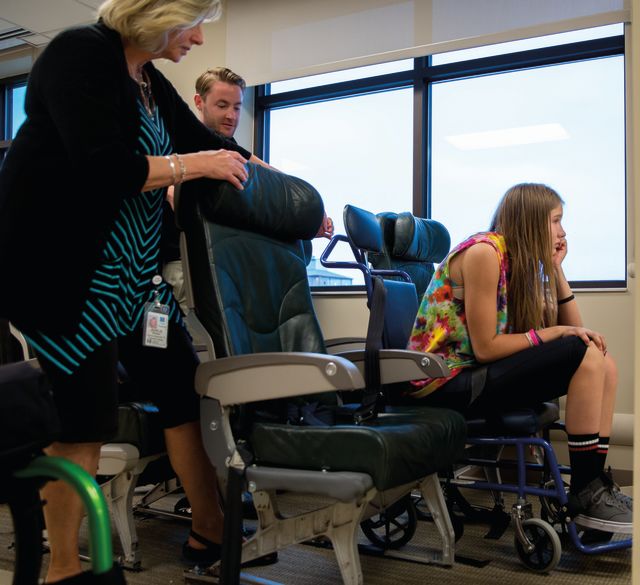
A final physical therapy session: practicing how to board a plane and a car with a wheelchair
Image: Dominique Taylor
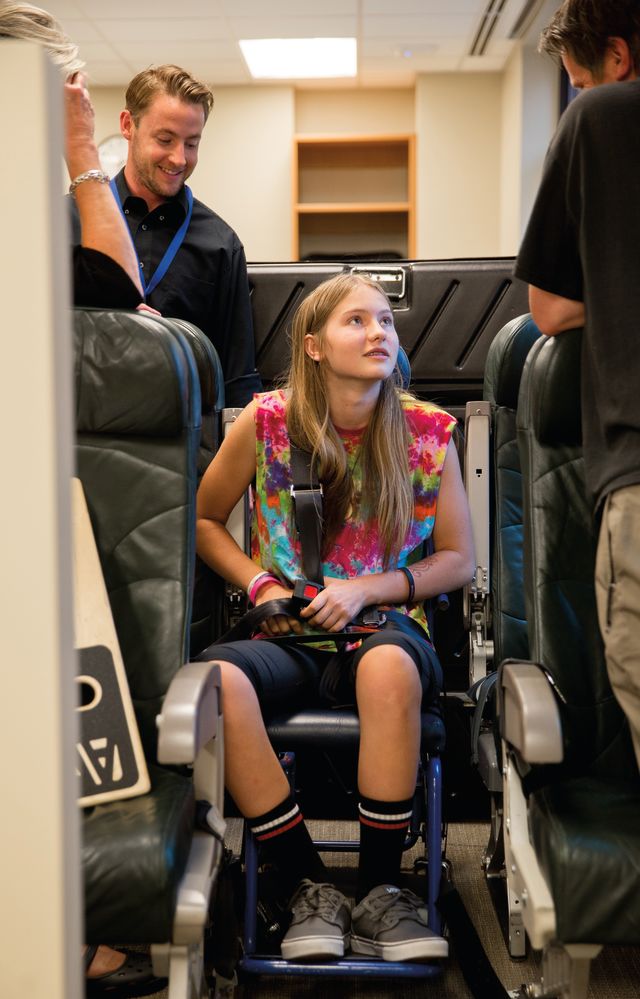
Image: Dominique Taylor
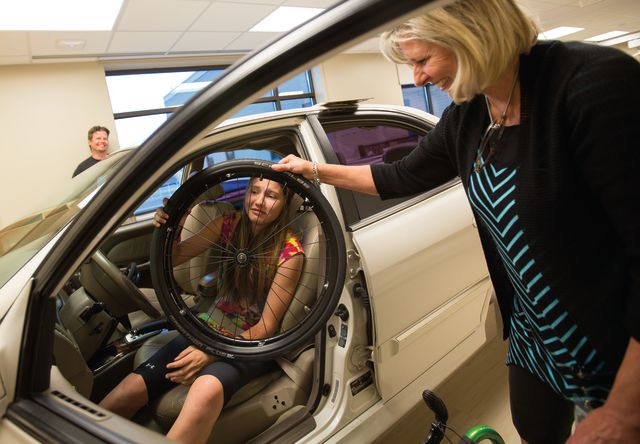
Image: Dominique Taylor
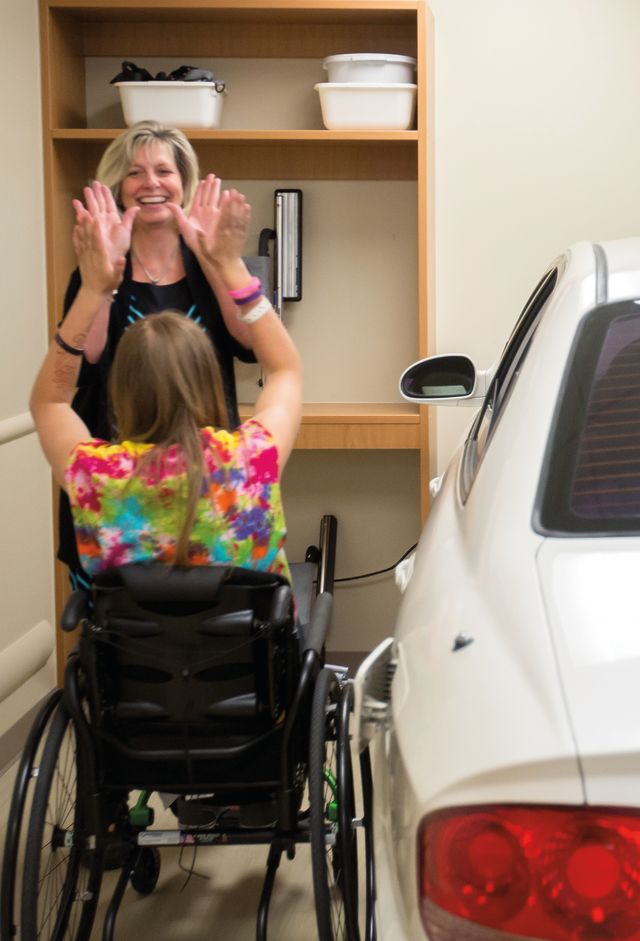
In 2010, when Forsberg joined Ski and Snowboard Club Vail, she impressed her coaches with a dogged determination to master advanced aerials. “Most kids can picture the big event, but they’re not willing to lay the groundwork with fundamental skills,” says SSCV freeskiing coach Bob Sonntag. Forsberg, however, logged long hours on the trampoline, honed the basics on smaller jumps, and braved the big stunts seemingly without fear. The day she landed her first big-league 360 in the Golden Peak terrain park at Vail was a highlight of Sonntag’s coaching career. “She just nailed it,” he recalls.
Forsberg never talked about making it to the X Games or the Olympics—but in truth, she rarely chatted about much of anything in public save for an occasional extemporaneous outburst of dry, sarcastic wit. (Her 11-year-old sister, Kiara, was always the loquacious one, though she didn’t care for sports.) Sometimes her taciturn nature could be painful to watch: during her first nationally televised sports interview at age nine, Forsberg grunted one-word answers into the microphone. But her physical feats displayed a precocious athletic vocabulary that got her noticed as one of freeskiing’s most promising up-and-comers. After two years in SSCV’s weekend program, she enrolled at Vail Ski and Snowboard Academy, a Minturn public school that organizes its curriculum and schedule around snow-sports training and competition.
But midway through last winter, Forsberg abruptly left the academy for closer-to-home Eagle Valley High. Since she now lacked an official coach to oversee training and shepherd her through races, her father, Gypsum Elementary School principal Mitchell Forsberg, navigated the maze of registration requirements and got her to the starting gates.
At Copper Mountain on the night before the slopestyle competition, race officials at the coaches’ meeting had discussed the likelihood of icy morning conditions. After a sunny spring afternoon, overnight temperatures had plummeted to well below freezing, which hardened the snow and made the features fast and unforgiving. But Forsberg had no representative at that meeting, and as she queued up for her second practice lap on the morning of April 7, without a dedicated coach, she received no cautions about the course, had no last-
minute admonitions about dialing things back accordingly, and was not asked whether she was wearing spine protection.
Feeling sparky and confident, Forsberg bulleted toward the first jump, popped off the top, and hurled her skis skyward.
Back flips may be the most underrated tricks in the freeskier’s arsenal. To spectators, corkscrews and other off-axis stunts appear to be riskier, when in fact they are less so, offering avenues for escape since it’s possible to make a relatively safe side landing. Not so with back flips, which provide few bailout moves when skiers over-rotate and keep spinning past the landing, as Forsberg did that fateful morning.
She fell to earth as kinetically as Yvain in Stardust, smashing into snow as hard as asphalt. The blow pulverized the seventh cervical vertebra in her neck, and although Forsberg remained conscious after her crash, she couldn’t feel or move her legs. Her family never saw the accident (her father had been riding the chairlift; her mother and sister had been walking to the start), but they watched, horrified, as rescuers strapped her onto a ski patrol sled then loaded her onto a Flight for Life helicopter that airlifted her to Denver.
Physicians at Children’s Hospital Colorado repaired her fractured pelvis and dislocated hip and did what they could about her broken neck. Thirteen days later, when she was transferred to Craig Hospital in Englewood, she’d already regained some feeling in her back. But her initial goal at the rehabilitation facility wasn’t focused on her legs: it was to restore the full use of her arms. As a C7 tetraplegic facing the rest of her years confined to a wheelchair, she was going to need them. Even more daunting was the prospect of mobility: ultimately this grounded fly girl had to figure out where she wanted to go.
Before her accident, Forsberg was a risk taker who plunged headfirst and exuberant into the unknown. As a kid, she thought nothing of jumping off of 40-foot cliffs into Lake Powell. So it’s hardly surprising that she gravitated toward slopestyle, one of the most dangerous events in skiing.
During the 2014 Olympic Winter Games at Sochi, Russia, about two dozen athletes were injured in the terrain park (including the halfpipe, slopestyle, and ski/snowboard cross courses). The most serious incident involved the host country’s Maria Komissarova, who broke her back and was paralyzed after a ski cross training run. But to Lars Engebretsen, head medical officer for the International Olympic Committee (IOC), the number of slopestyle injuries seemed most concerning. He declared its injury rate “unacceptably high.”
Indeed, there’s a grim history of smash-ups and even death among freeskiing pros. Sarah Burke died after a 2012 accident in the halfpipe at Park City (where, coincidentally, snowboarder Kevin Pearce also sustained a head injury while training for the 2010 Olympics). Other pros, including Gretchen Bleiler and Scotty Lago, estimate that they’ve suffered five to seven concussions apiece throughout their careers. “It comes with the territory,” Bleiler told USA Today in 2013.
Young freeskiers are getting hurt, too. Five months after Forsberg’s fall at Copper Mountain, her 16-year-old friend Sam Jackenthal of Park City crashed during a training run in Australia, leaving his brain so battered that he died from complications in early October.
Incidents such as these have prompted Tom Hackett to launch the first-ever study into slopestyle injuries at major competitions. An orthopedic surgeon at Vail’s Steadman Clinic and a physician for the U.S. ski and snowboard teams, Hackett hopes that the compilation of injury data will convince officials at the IOC and the International Ski Federation to adopt consistent snowmaking and jump-design standards. Currently, snow conditions and course construction vary widely from venue to venue. The jump that launched Forsberg into her neck-breaking fall was “a little lippy,” she says—meaning it gave skiers extra thrust into the air.
As it is now, slopestyle skiers must intuit their way through each course they attempt, making on-the-fly assessments of the various jump angles and landing lengths. Experts like Hackett hope that instituting consistent standards might make an inherently risky sport somewhat safer. That’s something that everyone—from the IOC on down to coaches mentoring hopeful kids at ski clubs like Vail’s—feels slopestyle desperately needs.
“I can’t. My arms hurt so bad, and I don’t feel good, and I can’t do this right now,” a defeated Forsberg grumps, sitting in her wheelchair at Craig Hospital with her chin on her chest. Her long, straight hair hangs like a curtain, hiding her face.
It’s early July, just a few days before Forsberg is scheduled to leave Denver and resume her life in Eagle (where her dad lives) and Gypsum (her mother’s home). Her fellow patients arrived here following debilitating car accidents, falls, and chronic illnesses; it’s Craig’s mission to help them regain independence in the wake of brain, neck, and spinal cord injury. For months, Forsberg has undergone daily physical therapy in the bright, gym-size room where the newly disabled try to stand, or walk, or even struggle to make a fist. Group lessons in the center’s pool reintroduced her to swimming, while road trips got her hand-cycling on a recumbent powered by arms instead of legs. She cringed in awkward discomfort during some of the outings, but she also developed close friendships with some of her fellow teenage internees—and the busy, therapy-filled days eventually yielded tangible results: although Forsberg started her journey at Craig last spring as a Category A patient (having no feeling or movement below her chest), by summer’s end she had recovered full control over her arms and fingers and could voluntarily wiggle a toe, which advanced her to Category C (possessing some feeling and movement below the injury site).
But today’s transfer training—a rehearsal for future plane and car trips—is proving to be too much.
“I’m not using an airplane anytime soon,” she insists.
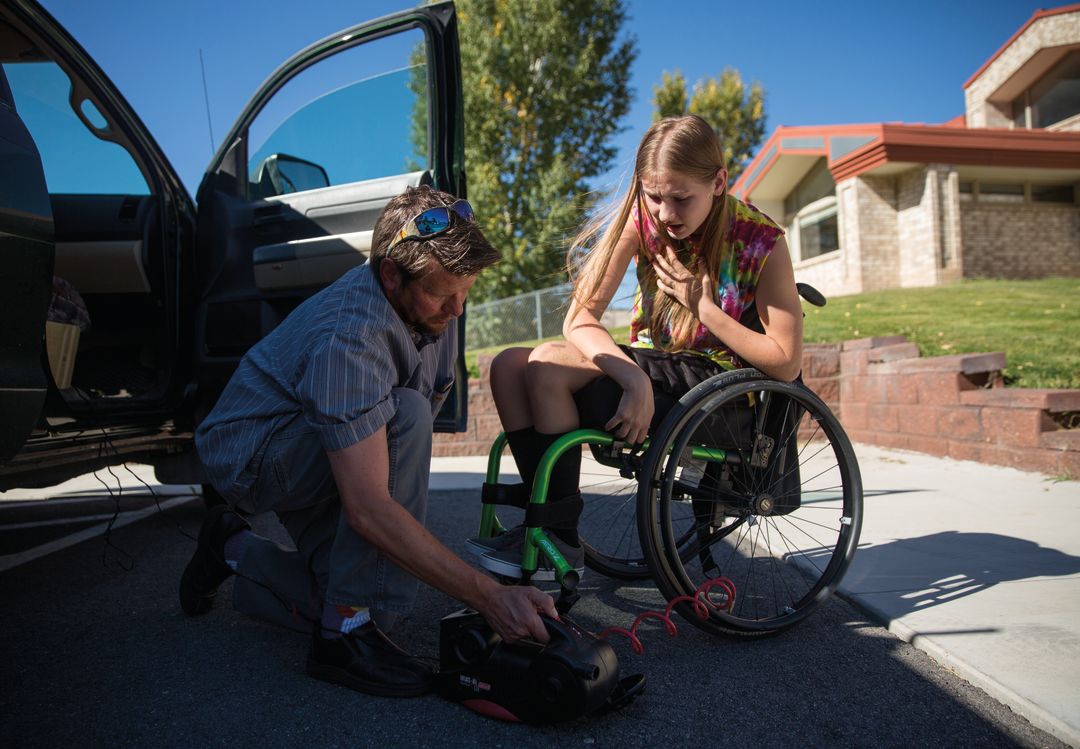
Pressure check: topping off tires before rolling into Gypsum Elementary
Image: Dominique Taylor
In one corner of the hospital training room, rows of actual airline seats create a stage set that allows patients to practice the logistics required to negotiate a plane ride in a wheelchair. Nearby, a Hyundai Sonata (license plate: “IMCRAIG”) is a proving ground for road-tripping. With its sawed-off front end abutting the wall, the car looks like someone drove it right through the plaster. And its next driver is unlicensed: having muddled her way through the mock plane trip, Forsberg faces a second assignment of transferring herself into the driver’s seat and getting her wheelchair positioned beside her.
Parked beside the Sonata’s portside open door, she leans in and grabs the steering wheel. It rotates, and she falls sideways onto the front seat.
“I would not put your head in until you get your butt in,” advises Adele Stadler, her physical therapist.
“Thanks for the heads-up,” Forsberg deadpans as she struggles to push herself back up. “What kind of car is this, anyway? Like a ghetto car that you see in the ’hood, all low riding?”
“I bought it for you,” smiles Stadler.
“I’m never driving anyway,” says Forsberg.
“Well, you might change your mind,” replies Stadler, persisting with her instruction now that her charge is installed behind the wheel. Packing and stowing the chair comes next. “Now what you want to do is take that wheel off. If you have a person with you, they’ll put the chair in the car for you.”
“Yeah, that’s what friends are for,” Forsberg quips.
“But if you’ve lost all your friends ...” her father reminds her.
“... which is a possibility,” adds Stadler. This session hasn’t been easy. Forsberg rolls her eyes.
“Well then, be nice to people, and maybe they’ll help you,” Mitch Forsberg replies.
His daughter continues to stymie the program. “Contains added flame retardant,” she reads from a label inside the car. “What’s that?”
Stadler persists with the lesson. “Kailyn, you’ve got to hold the chair. Pretend I’m not here.”
“But you are!” Forsberg exclaims.
After 25 minutes of strife, the teen and her wheelchair are finally tucked inside the car. “That was a terrible trip,” she jokes.
“You will get it down to an 8- to 10-
minute process,” promises Stadler.
“That’s too much!” Forsberg objects; driving, a rite of passage that typically offers teens a much-coveted ticket to freedom, is yet another anxiety-enhanced roadblock for her. Even routine trips to the bathroom have become fraught with indignity, now that she must use a catheter to relieve herself (and the hospital nurse charged with teaching her that procedure was, mortifyingly, a man). What Forsberg craves—far more than the independence of a driver’s license—is a respite from her daily routine of sucking at everything she does.
Her happiest memory at Craig, she recounts, was when pro freeskier Bobby Brown came to visit her. She grilled him steaks at the hospital’s picnic area. “We rapped about skiing. It was really cool,” says Brown. “She seemed really optimistic, like she was ready to take this journey head-on.” Forsberg, meanwhile, savored the chance to feel like a member of skiing’s tribe again rather than an exile. It was a blessed two hours where she could pretend she was back in her former life—and not have to think about the future. That’s what she dreads most about those sessions in the fake plane and car at Craig. Because whenever she considers the long-term implications of her injury, she’s spun like a falling star out of her predictable athlete’s orbit, consumed by nagging doubts: Will any boys ever like me? How will I go to college? Will I ever ski again?
On the day she left Craig in August, her fellow patients presented her with a signed T-shirt. “Don’t forget! Matching tattoos!” one of her closest hospital friends wrote, referring to a mutual pledge to ink skin with an indelible rendition of the Broken Man. It’s the official symbol of Craig Hospital, a diptych of a stick figure represented two ways: on the left, the caricature is deconstructed, a jumble of shapes and lines; on the right, she is reassembled into a whole person.
At Mitch Forsberg’s house in Eagle, there’s a new cement wheelchair ramp that climbs from the driveway and switchbacks up to a just-built patio and secondary entryway that once was a bay window. Now, it opens into his daughter’s new ADA-compliant one-bedroom apartment.
Within a week of her accident, a former neighbor who worked as a contractor offered to make the Forsberg residence more accessible. At first, Mitch resisted the idea, because it assumed his daughter wouldn’t be walking upon her return. But six weeks later, he gave his OK to the army of big-hearted handymen and women who remodeled the entire ground floor while he lived with and supported his daughter at Craig. As a longtime Vail Valley educator, he has nurtured hundreds of local kids over the years. In the wake of his daughter’s accident, those families and many others returned their debt with interest.
One friend donated new plumbing fixtures for the wheelchair-accessible shower. Another contributed gleaming Arrigoni hardwood floors. Someone else insisted on widening the interior openings to 36 inches and installing pocket doors, which are easier for someone confined to a wheelchair to open and close. A kitchenette was created on one side of the sitting room, which also contains a massive new flat-screen TV. Photos (including a framed snapshot of Kailyn and Bobby Brown at Craig) and trophies (from Cougar football and the 2013 Rocky Mountain Freestyle Divisional Championships) weight the wall-length shelf above the sofa. Dominating the center of the room is Kailyn’s standing machine (a mechanical device worthy of Tony Stark’s Iron Man, which, she notes wryly, once malfunctioned and held her prisoner for 45 minutes in the now-unfamiliar straight-legged position). At home in a teenager’s dream suite (with walls painted her favorite color, teal blue), Kailyn never returned to the second-story bedroom she last slept in on the night before her accident. It’s been claimed by Kiara.
The girls’ father doesn’t know what it all cost. Thanks to the outpouring of donated supplies and labor, he estimates he’s paid just five percent of the remodel’s cash value. The truly scary bills are for Kailyn’s medical expenses, which approach $1 million.
To that end, the High Fives Foundation has pledged support for her acupuncture and massage treatments; with the help of Derek and Beth Pappas of the Vail Recreation District, High Fives also organized a golf tournament and silent auction that reduced Kailyn’s medical bills by $4,500. Donations through her YouCaring web page (enter “Caring for Kailyn Forsberg”) totaled more than $89,000 at press time, and an August fundraiser hosted by the Vail Valley Charitable Fund helped temper Mitch’s debt from eyeball level to something in the neighborhood of his chin. To the Forsberg family, the outpouring of community support is just as valuable: a crowd of 800 packed into the Eagle Ranch Pavilion, and the rally spoke volumes about the valley’s willingness to rally around one of its own.
“She’s got a ginormous personality,” attests Roy Tuscany, executive director and cofounder of High Fives. “She shines beyond any item like a wheelchair. This injury is not a setback; it’s a setup for success.”
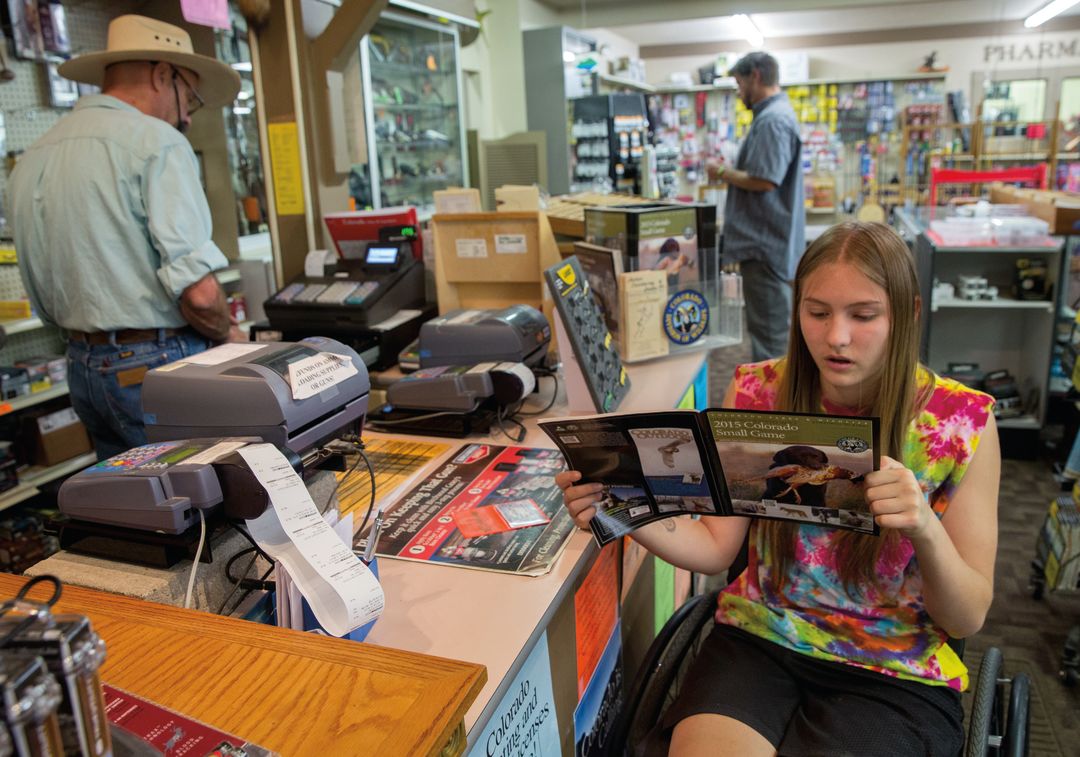
A shopping excursion to Eagle Pharmacy to purchase a small-game hunting license, part of Mitch Forsberg’s plan to get his daughter outdoors again
Image: Dominique Taylor
With that in mind, Forsberg’s father has tried to interest her in hand cycling, only to be rebuffed. Neither has she embraced kayaking, which he also proposed. But the family has gone fishing at Sylvan Lake and taken their motorboat out to Rifle Gap—things they all enjoyed before the accident. “I’m trying to figure out how to do stuff and make it totally normal, when at the same time it’s all new,” Mitch explains. “My feeling is, let’s just rip off the bandages. Let’s get all those firsts out of the way.” But it hasn’t been that easy. The sleepover or movie date with friends, the camping trip in the Forsbergs’ 1973 trailer, the visit to see family in Michigan—the wheelchair makes all of these once-familiar routines seem like expeditions into uncharted territory. The longer such things remain undone, Mitch reasons, the more intimidating they’ll seem to Kailyn. As for the elephant lurking in the teal-hued room (will she ski this winter?): “We haven’t talked about it,” Kailyn evades.
Yet she still enjoys target shooting with her father’s .357 and shotgun. Ever since Kailyn was a child, she’s joined her dad on duck-hunting trips with her graying bird dog, Grizzly. She’s also gone after deer; in fact, she’s got a tag for a 2015 hunt in Utah. Acquaintances have even offered to gift her a deer hunt on private land near home, if it means she’ll get out and get after it. Some days she wants to. Most days, not so much.
“It’s got to be frustrating, not being able to play lacrosse and all that anymore,” admits her best friend, Sasha Eason, a 14-year-old from Glenwood Springs who accompanied Forsberg on the fishing trips to Rifle Gap and Sylvan Lake. “She’s cried about it in front of me. It’s been really hard. But she has a lot of friends in Eagle and Gypsum that support her.” Plus, Eason explains, Forsberg isn’t so consumed with her own misfortunes that she views others’ problems as insignificant, adding, “I can tell her anything, and she won’t judge me.”
On her best days—such as during the cookout with Brown—Forsberg seems as selfless and as lionhearted as the girl that friends like Eason and supporters like Tuscany describe. Other times, she balks at the unknowns ahead and turns inward. But emerging research backs her backers’ optimism. In his new book Upside: The New Science of Post-Traumatic Growth, journalist Jim Rendon explores the tendency for trauma survivors to emerge as stronger people. He builds on landmark research conducted in the 1980s by two psychologists, Richard Tedeschi and Lawrence Calhoun, who conveyed that many of the more than 600 subjects they studied actually reported that their lives had improved following episodes of illness, injury, violence, or other traumatic loss.
“The suffering that resulted from these horrible experiences was not an endpoint,” writes Rendon. “Instead it acted as a catalyst, pushing these people to change for the better.” Some said they became closer to family and friends, or began steering once rudderless lives toward more meaningful pursuits, or leveraged profound loss into cultivating greater inner strength. One subject, a professional freeskier who was critically injured in a wingsuit flight gone wrong, described how the accident cost her a career—but “opened up an entire part of her identity she never would have known about otherwise,” writes Rendon.
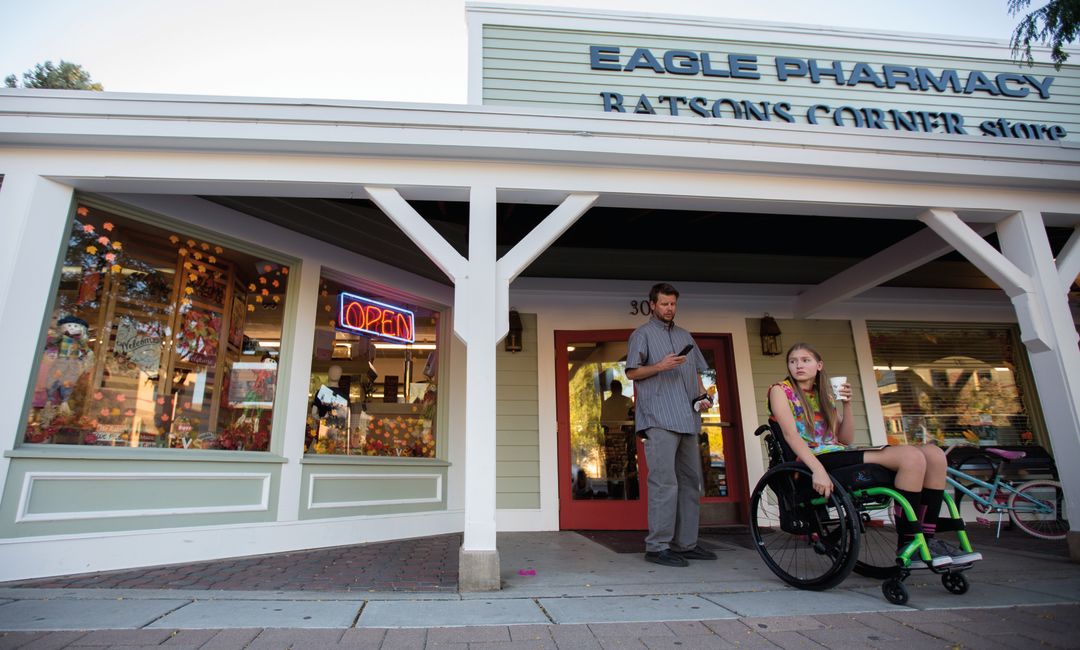
Image: Dominique Taylor
Forsberg’s accident stole the only identity—and form of self-expression—that she’s ever known. Now, it’s her job to break and remake that mold. She may opt to recast herself as an athlete, especially now that so many adaptive sports programs provide people of all abilities a way to ski, bike, run, play basketball ... the list goes on. Or she might reemerge from the chrysalis of crisis like a caterpillar borne on newfound wings.
On a bright late-summer morning, Forsberg is trailing her dad and sister through the produce department at the Eagle City Market, considering a hill of watermelons, when a wayward shopper interrupts her reverie by ramming his cart into the back of her head.
“Sorry!” he blurts, eyes aghast with remorse. Kailyn’s face is inscrutable. “That’s OK,” she says, without turning to look at him. It’s her umpteenth lesson about life in a wheelchair: you’re so invisible, you may be struck in the head by a distracted shopping-cart driver. It’s just another reality of learning to live below everyone else’s eye level.
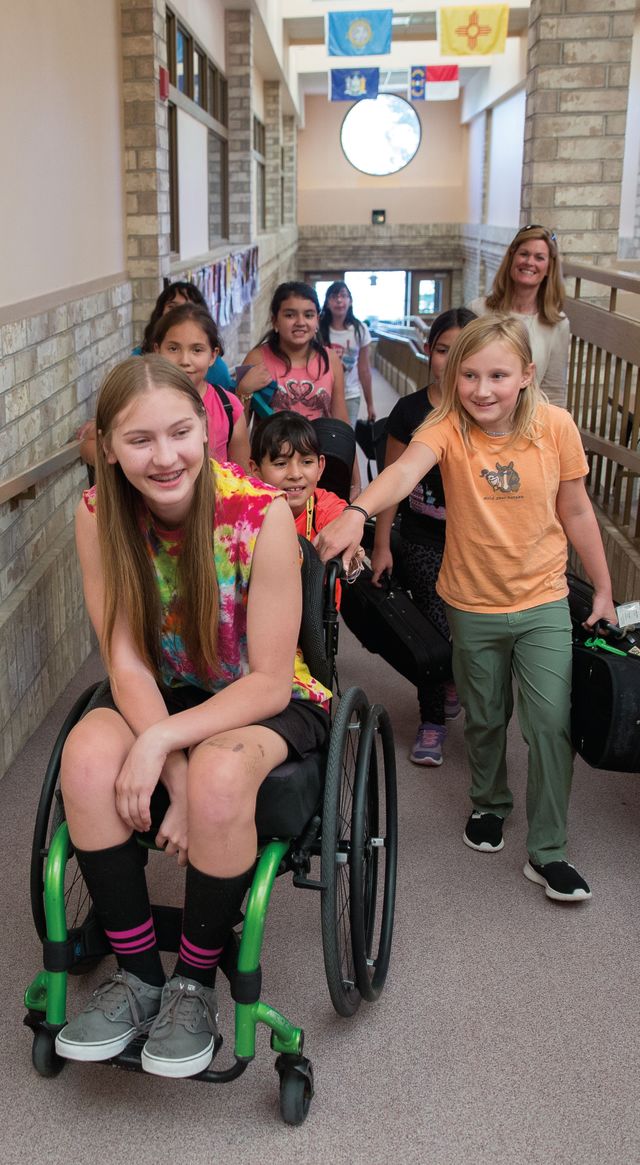
Image: Dominique Taylor
Each day begets yet another lesson in humility, and for Forsberg it’s happening at puberty, that awkward age of metamorphosis that seems traumatic enough to most kids—let alone one now recognized as “that poor girl in the wheelchair.” A ponytailed woman on crutches hobbles over to the Forsberg clan to report that her knee surgery went well. “We’re just trying to get her out and about,” explains her husband. “There’s a lot of that going around,” Forsberg’s father deadpans. Like his daughter, Mitch is fluent in sarcasm, but he can also verbalize the stuff unsaid. “In some ways, this [accident] has matured her a ton,” Mitch says. Kailyn now knows, he asserts, better than many adults, how to deal with disappointment in life. “But she’s also reverted back to some insecurities,” he adds. At 15, when most kids her age yearn for life outside the parental bubble, Kailyn begs her dad to guide her through the mundane—like trips to the meat aisle. Mitch has dedicated himself to pulling his daughter out of the safety of his orbit.

The grocery excursion was his idea, and to overcome Kailyn’s reluctance Mitch promised frozen Starbucks drinks for her and Kiara. Trolling the aisles, the sisters fill the cart with monkey bread, cake mix, and steaks. Kailyn fidgets by popping wheelies in her chair. Progress is slow, with neighbors stopping to say hi to the girls or to grasp Mitch’s hand in both of theirs. “I’m here for anything you might need,” one stranger tells the girl in the wheelchair, who bluntly asks, “Who are you?”
It’s a question that Kailyn Forsberg, who once soared so high, asks herself every day. One thing’s certain: in January, after she turns 16, she’ll get Craig Hospital’s Broken Man inked into her skin. Her own pieces might still defy order, and ultimate reassembly may not include the ability to walk. But the symbol promises that one day, once she allows herself to stop falling, Forsberg will stick a safe and perfect landing.






































